MyHimalayasimpressions from |
|
|||||||

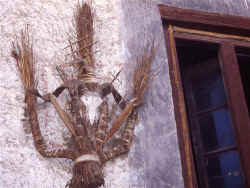
Ghost trap over the entrance, a common sight in remote villages.
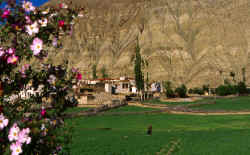
The morning sun brings out the stunning colours.
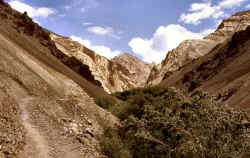
Gentle walk between barren hillsides along the creek.
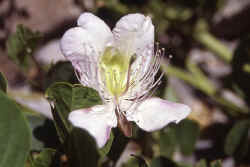
Vegeration along the Wuleh Tokpa surprises with its colours.
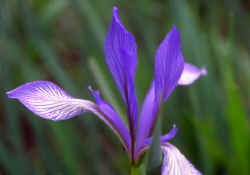
Colourful flowers bloom in the the fields.
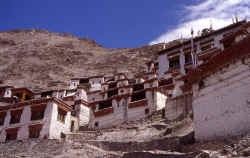
Two hours south, in a hidden sidevalley, lies the large Gelugpa monastery of Rizong.
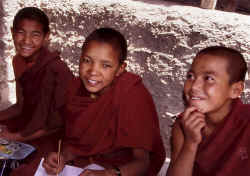
Novice monks learn English, math, Tibetan and Buddhist philosophy.
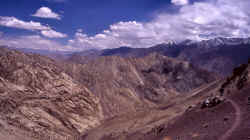
Climbing up the pass, looking back to Rizong valley.
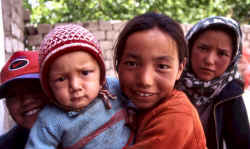
Kids in Hemis Shakpachen who helped me find a place for the night.
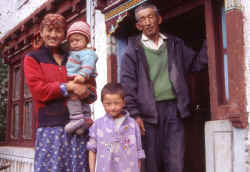
Family running the guesthouse in Hemis.
Likir: Yangtang - Rizong - Hemis Shakpachen
Yangtang - Hemis
Yangtang Ė Rinzong Ė Hemis Shakpachen (Day 4)
When the sun rises I get up and walk around in the village. Though I am up very early, life has already started. The village is like a miniature version of Lo Manthang, the walled in capital of Mustang in Nepal. Each family owns a house, and they are built completely wall to wall, or so close to each other that they are connected by their roofs. The architecture looks very robust, the whitewashed buildings are two to three stories high and very solid, without looking clumsy. Narrow alleys lead to the small doors on the ground floor, some houses have wooden ladders going up to the second floor where the living quarters are. A ghost trap protects the main entrance. The skull of a goat is decorated with a web of colourful strings so that ghosts get caught in it.
The monastery builds the center of the village. The village is too small to support a monk, so a layman takes care and performs the morning and evening ritual and takes care of the shrine. During important festivals and dates in the Tibetan calendar monks from the close-by Rizong or Likir monastery assist in the ceremonies. Especially for older people (whether because they have more time or are more traditionally) the gompa is a central place, they circumambulate it or sit down near the big prayer wheel, turning it occasionally. Grandfather wears the traditional Ladakhi chuba, a long woolen coat, and Nike shoes. Norbuís brother wears jeans and the traditional Ladakhi woolen shoes, both are interesting combinations.
People still live largely self-sufficient; for breakfast we eat chapatis with self-made butter and home-made apricot jam. The large chunk of butter I am served for breakfast shows generosity. Yesterday evening I saw how time-consuming the making of butter is Ė a wooden vessel is tied to the main beam supporting the living room, and a rope is used to swing a stick to churn it.
The women are already in the fields by now; men are working in the house, fetch water or drive the cattle to the hills above the village. Despite the altitude and the long harsh winters, Ladakh is very frugal Ė provided there is water to irrigate the fields. Barley does not need a lot of water, but since it is scarce, it has to be distributed carefully. A small channel brings water from the the creek into the fields. Little branches from the channel bring water into each patch of a barley field. Inside the field there are more and smaller channels. The women are constantly closing and opening the channels, until the small barley sprouts have received the required amount of water. The fields stand out in a bright green and are further accentuated by the sunlight; and channels between them look like silver threads. Blooming rosebuds in pink and white add more colurs to the picturesque scene. Itís very tempting to stay another day, but the weather is so great today that I should go on.
There are two routes to continue, one goes directly to Hemis Shukpachen over a low pass (Sarmanchan La, 3'750 m) to the west; the other way takes a long detour to Rizong monastery in the south. Though I didnít feel particularly strong yesterday I take the longer way, not worrying too much about yesterday since it was just my third day at altitude and Iíll acclimatize well. I pack up, say good-bye to the host family which made me feel like a real guest and not a paying customer, and start down the valley. From higher up it looked a little intimidating Ė just barren steep rock faces Ė but once Iím at the valley floor itís very fertile and the brook called Wuleh Tokpo gives the gorge an idyllic appearance. Thorny bushes are blooming in red, white and pink. Willow trees with green leaves, and dark coloured junipers attract many birds. In addition to the sparrows and magpies thereís crows, swallows and a little orange-black coloured ones. The reddish crags are topped by fluffy white clouds, a great scene that remains all the way down to Rizong.
Only one building appears on the way down, a house between a little forest on the left side of the river where one nun is living. Iím not sure whether to take a little side-valley now or if Rizong is further down Ė the nun waves and points further down. Some rockslide areas later I hit the road Ė an unexpected and unpleasant surprise. Iím not sure about the trail any longer, and with some relief see the side valley to Rizong five minutes further down. A barren valley twists and turns a few times before the main valley opens up and displays the picturesque Rizong gompa. It stands at the end of the valley, its countless buildings look impressive and are spread out like an amphitheatre. The construction of a new monastic school at the foot of the monastery distracts visually from the great old buildings, but itís good to see such big investment in education. A maze of stairs go up to the white buildings, by coincidence the first major building is the (old) school where a friend of the Yangthang teach, Norbu, is teaching English and Math. Sonam studies history in Chandigarh Ė the capital of Punjub Ė but got sick of it and has taken a break he said laughingly, adding that this might be a very long break from studying. The monastery of Rizong is well-known for its discipline. 22 young monks are taught philosophy and classical Tibetan, in addition to Sonamís subjects. Unlike in regular government or private schools, science is not part of the curriculum. Sonam wishes it would be added soon, so that Tibetan philosophy will be easier to understand for students. Science and philosophy donít contradict each other in Buddhism, he explains.
Itís hard to get moving again: another cup of tea, a longer conversation and some more shade would be good reasons to stay longer. But Sonam has to help students with homework, and I should get going otherwise I wonít get to the next village in daylight. Before setting out, I visit the monastery. A Zanskari family on a pilgrimage is waiting in the cool courtyard for the keeper of the key. I wait with them and get to see some rooms which are usually closed. The old large assembly hall contains statues and a silver chorten but the missing cushions for monks make it seem too clean and unused. The wall painting shows the history of Buddhism from the very beginning, how it makes it to Ladakh and into the Gelug lineage I canít decipher. One could probably be spend a day or week in front of it, I only have two minutes. In a separate rooms are the seats and instruments for the daily ceremonies, and the Kandur and Tanjur books of the Tibetan canon. A small room is the private chapel of the abbot, it is a well-lit and decorated room with fine statues.
Sonam explains me the way: itís quite easy, I just have to take the trail northwards from the monastery, and then be careful not to miss the first branch into the left valley, if I continued straight I would end up in Yangtang again.
Itís a very desolate valley, and it feels good to be on my own. This feeling of comfortable solitude is destroyed when I catch up with a large German group. Some of them are nice, others not. But thereís not much choice and I squeeze between the fastest of them. As soon as the trail gets steeper Iím reminded by my body that I havenít had lunch yet. After a liter of water, some glucose pills and a cereal bar I continue.
The trail goes up washed out hills and is barely visible at times, but far ahead I can spot a dip in the crest Ė that must be the xxx pass. The view back offers endless distorted hills and ridges Ė a lunar landscape. The view ahead is similar, if it werenít for the prayerflags at the pass which comes closer and closer. Just twenty minutes later, roughly 90 minutes after leaving the monastery, I traverse a steep last hillside and find myself on the top of xxx La. The pass separates the barren Rizong valley from the fertile Hemis Shakpachen. The Rizong side is utter desolation, ochre and red hills seem like dunes, the only change is the snow of the Ladakh range which rises high in the far distance. The Hemis side is dominated by the wide-spread green fields, resembling a green carpet that was laid between the arid hills. As usual, I let out a loud Ąsoso lha gyal lhoď when reaching a pass Ė the traditional Tibetan phrase. A German whom I passed on the way up seems eager to start an argument. I manage to ignore him, but do waste brain capacity on the way down asking myself whatís wrong with that guy.
I might have stayed longer on the pass with different company, but leave early. Itís a steep descent down a loose scree slope. I take short cuts and am almost able to jump down the soft slope. People with less sure-footedness might have a harder time, especially after bad weather washed out the trail.
When I reach the first green field after the gorge, I assume I have arrived at the village. I do feel quite exhausted, due to the heat and the sparse food Iíve had so far. There are a few guesthouse signs but whenever I follow them nobody knows where the hotel is. I guess end of June is at the start of the season, and most tourists will arrive in July or August. The sun is beating down and I must have been walking up the widespread village for almost an hour when I meet some young girls and ask them about a guesthouse. They take me past a campsite to a house behind it which really does take guests for a moderate fee of 100 rupees. On the roof is a large room with half a dozen mattresses along the wall and its windows. A long window front giving a good view down the valley, and makes the room very cozy. Iím the only guest and very happy about this luxurious accommodations. Though feeling very tired now, but manage to keep my social mood for a chat with the girls and some pictures. Then I crash down on the carpets, drink two liters of water and after a wash with lukewarm water in the garden I try to take a nap. I cannot fall asleep, but feel relaxed anyway. A Ladakhi girl is staying as a guest in a separate room. She quickly strikes me as very educated, and tells me sheís studying political science in Chandigarh. Sheís specialized in constitutions, esp. of UK, USA, Switzerland and India. I know enough about the Swiss constitution and history not to make a total fool out of myself, but Iím amazed about her knowledge and motivation to learn about these things. She grew up in another village in Ladakh, has left Ladakh for higher studies and rarely comes back. This summer she is visiting her father who is the headmaster of the school.
After a stroll through the fields I climb up a hill above the village to enjoy the effects of the setting sun. The fields are turned in to an intense green where people work until late in the evening. When they go home, I also pack my camera and head back to the guesthouse, eagerly waiting for dinner. The father of the woman who runs the guesthouse brings me a big bowl of rice, green vegetables and dal (lentils). I donít want to disturb the family and eat in my room, enjoying the steaming hot food even though temperatures outside are quite warm. Itís already 9.30 when I slowly doze off.
|
Summary Part 3:
I leave the beautiful Yangtang in the morning for Hemis Shakpachen. Instead of taking the direct route, I make a detour and follow a clear creek down to the monastery of Rizong. From there it is a hard climb up a pass with splendid views. The barren Rizong canyon is contrasted by the fertile and wide valley of Hemis, whose fields look like a carpet of green in the desert. The snow-covered Ladakh range forms the horizon. In the widespread village of Hemis it takes some time to find a guesthouse, but then I find a good place to stay and finally get some food and drinks. |